Wang, Microsoft Promote Computer Science in Schools Via TEALS Program
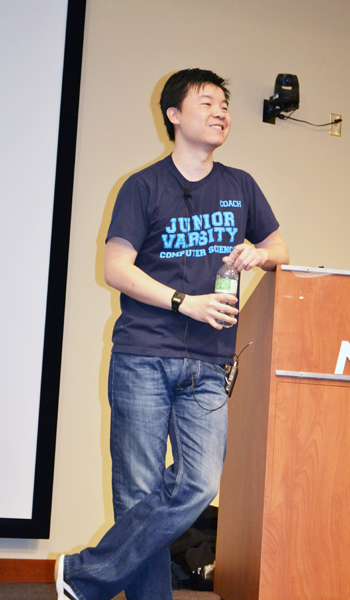
Kevin Wang of Microsoft discusses his TEALS program during a presentation at NCSA.
April 12, 2013
Kevin Wang of Microsoft is on a mission. He'd like to see every high school student in America have the chance to take a computer science course. But that requires that every high school in America offer a computer course. So he's been tackling the problem…one school at a time. Now his Technology Education and Literacy in Schools (TEALS) program is in 35 schools and seven states. However, according to the last national study he saw, out of the 45000 high schools in America, around 38,000 don't offer computer science at all.
During Wang's April 9, 2013 campus visit, sponsored by the iRISE program, he stressed that TEALS specifically targets computer science (CS), which he says has been left out of the recent push for STEM education that has swept across America. "STEM is a big, big umbrella. To be honest, in the K-12 space, while the whole STEM thing has gone over for the past decade or so, STEM, STEM, STEM—the war drums have been beating for STEM for a while. But computer science has actually been left behind."
Another of Wang's concerns that TEALS is seeking to address is technology literacy. While high schoolers' lives are totally dependent on technology (cell phones, the internet, computers, etc.), according to Wang, they have no idea "how things go from one end of the internet to the other in mere seconds" for instance. They just take technology for granted and have no idea how "this 'magic' that they see all around them" actually works.
Here's another misconception Wang seeks to address: most people assume that the presence of technology in schools eliminates the need for computer classes. "A lot of people think having iPads in the classroom, or computers, or whatever, kids automatically learn computer science from that. That is obviously not true, because if that's true, the CS major would not exist if it just happened by osmosis…by proximity to a computer.
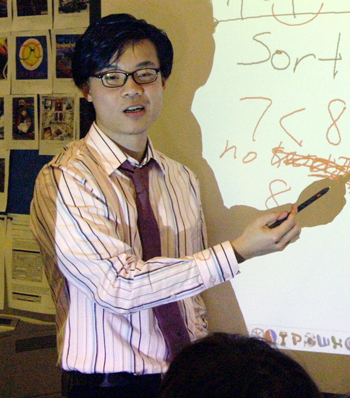
Kevin Wang teaching CS before TEALS began.
Wang's measure for student access to CS is the number of high school students enrolled in college-level AP (Advanced Placement) courses nationally who take the CS AP test.. Evidently, while the number/percentage of students taking AP tests are high for other STEM disciplines, CS ranks close to the end of the line, next to Art History. Given our society's dependence on computers, Wang finds this lack of access to CS courses in high schools disturbing. (And many folks at his presentation began to agree with him. During his talk, as he was presenting the bleak picture, he would ask, "How many are depressed now?" More and more of the audience began to raise their hands.) Stresses Wang, "Computer science has permeated every field. It doesn't matter if it's just the hard sciences, finance, retail. Whatever field students want to go into and end up in, computer science will be there. It's just going to be a fact of life."
Wang stumbled into his CS crusade by chance. After receiving an engineering degree in CS from Berkeley, he taught CS in high school for three years before getting a Master's in education from Harvard, then finally settling down at Microsoft. But he missed teaching.
"Once you're a teacher, it's really hard to not wake up at 6:00 am thinking, 'There is a whole room full of kids waiting for me.' I just naturally wake up really early. So it's like, 'Now what? I could go to the gym, or catch up on last night's Daily Show or Colbert Report or something. What am I going to do with my mornings?'"
By coincidence (which Wang terms "serendipity"), a local school that needed a CS course heard through the grapevine that he was a teacher, and approached him. He responded, "Hey, you know what, if you put it first period, like 8 to 9 o'clock, I can drive over to your school…teach for an hour…get to work around 9:30ish, and I'll still be one of the first engineers at work!'"
From his personally teaching a CS class in one school four years ago, the grass-roots initiative has mushroomed. Other schools got wind of the arrangement and begged him to come help them. "I was like, 'No, I can't. The laws of Physics say I can't be in multiple places at the same time. But I'll go ask around and see who else wants to do this.'"
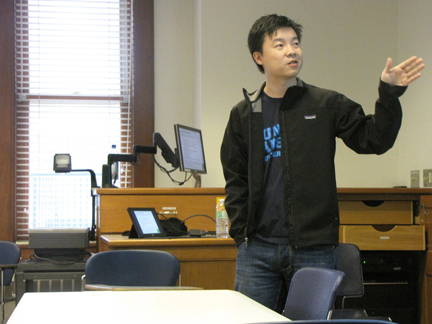
Kevin Wang presents his TEALS program to the iRISE students.
Since he works at Microsoft, finding other CS engineers was easy. TEALS grew to four schools with about 10 people the second year, and to 13 schools with about 30–35 people the third year. This current school year, TEALS is in 35 schools in seven states, with 105 volunteers. "So the demand is definitely there," reports Wang, "and the volunteer force is there, and people want to do this."
As TEALS grew and was requiring more and more of Wang's time to administrate, he began considering leaving Microsoft and making it a non-profit. His boss at the time heard of his dilemma and set up a meeting with the server tools and business president. No doubt cognizant that his industry needs to ensure a talented, well-educated pool of CS engineers from which to recruit, he said, "This is something that is really, really important…Just do it here inside of Microsoft... Concentrate on what the core of TEALS is about, which is making sure that as many kids who want CS can get computer science in school."
Through trial and error, the program, which involves engineers working with in-service teachers to teach a CS curriculum, has evolved. It includes a training period over the summer for the engineers, many of whom have never taught. Each class has at least two engineers and two teachers at a time, to achieve the low teacher-to-student ratio necessary because of the hands-on nature of CS and to provide students multiple, one-on-one interactions with instructors. In addition, to prevent burn-out, each participating classroom is assigned four engineers who alternate days.
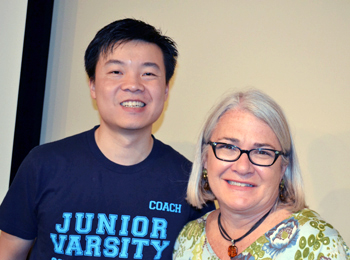
Kevin Wang, Director of Microsoft's TEALS program and I-STEM Director Lizanne DeStefano
An important premise of the program is that the CS folk serve as role models for the students. With standards being an important buzz word in education these days and with the Next Generation Science Standards due to come out any day, is the dearth of computer science teachers/courses something the inclusion of CS standards might rectify? Wang says no.
"The problem in computer science is not curriculum." He proves his point via a spontaneous anecdote about a high school with three physics teachers who all use the exact same curriculum. According to Wang, the kids from one class all come out saying, "Physics is awesome…I'm going to do it in college!" while the kids from the other two classes are like, 'I don't understand what Physics is, and why it's important, and would never want to touch Physics ever again!" Says Wang, "The most important thing is not the curriculum per se, but it's always the person standing in front of the kids…It's the people—someone in front of the kids needs to have a CS background and be a role model to actually teach them that."
For CS engineers who want to give back to the community, working with TEALS is a marriage made in heaven. Wang compares it to Teach for America—but better. "Teach for America asks you to put your career on pause for two years. This way you have your cake and eat it too, so to speak. You keep your day job; you pay back your student loans or continue to pay your mortgage or whatever; you just get to wake up a little bit earlier instead of going to the gym."
While Wang's competititve nature would no doubt feel gratified to see computer science come closer to matching the other sciences in the AP rankings, that's not his ultimate goal. It's to ensure that CS is a viable student choice. He says, "A bigger goal is to make sure every American high school student that wants to take computer science will be able to choose that as an elective at their own high school." Adds Wang, after doing some mental math: "38,000 more high schools to go."
Story and photographs by Elizabeth Innes, Communications Specialist, I-STEM Education Initiative.
More: 8-12 Outreach, Computer Science, iRiSE, Policy, 2013
For additional information about TEALS:
- WCIA's coverage of Wang's visit
- New York Time Article: Fostering Tech Talent in Schools
- The High School Computer Science Shortage and How You Can Help flyer
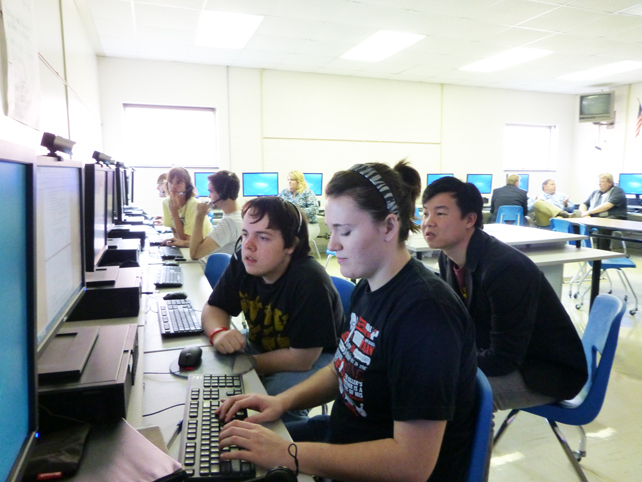
Kevin Wang (right foreground) during a visit with TEALS students in Kentucky.













.jpg)
















